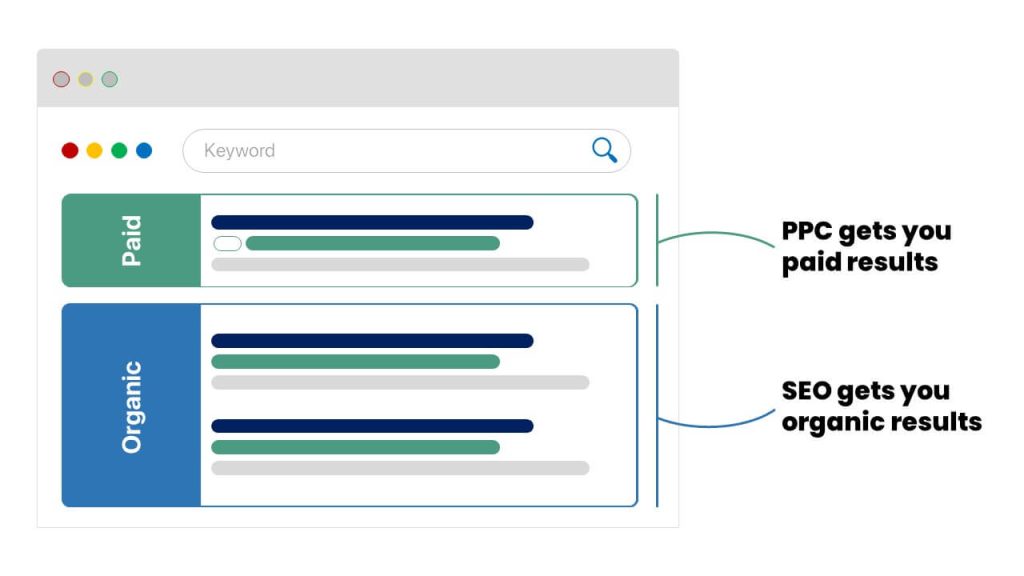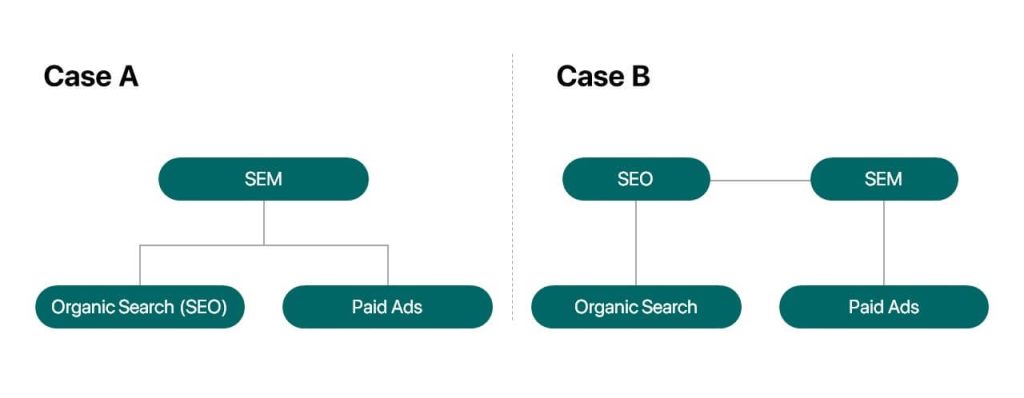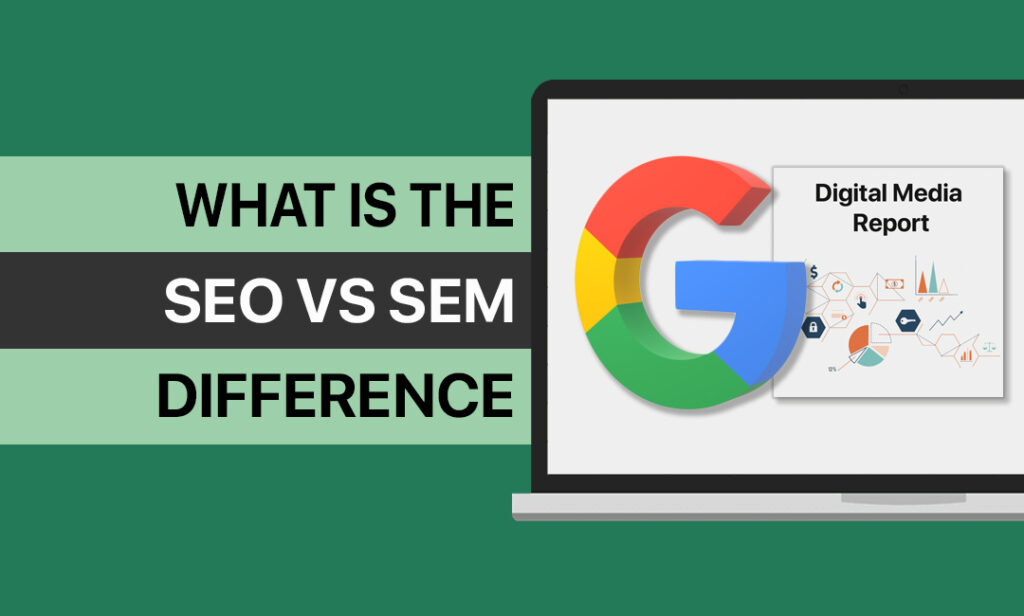SEO vs SEM is a pretty common question in digital marketing. Let’s address it.
In simple terms, the main difference between Search Engine Optimization (SEO) and Search Engine Marketing (SEM) is that SEO is focused on optimizing a website to get traffic from organic search results. On the other hand, SEM is used to get traffic and visibility through paid search predominantly.
Google’s search results are divided into two main categories: paid search results and organic search results.

Some people think of SEM as a broader umbrella that includes both paid ads in search engines and SEO (case A in the image below). However, for simplicity, we will say that SEO focuses on ranking websites through organic search results while SEM uses Paid Per Click (PPC) to get traffic (case B in the image below).

SEARCH ENGINE OPTIMIZATION (SEO)
Search engine optimization (SEO) is the process of optimizing a website to get ranked on the organic, non-paid search engine results page (SERP). At the most basic level, SEO involves optimizing content around commonly-used search terms, called keywords, to improve a website’s position in search engine results pages.
Typically, the higher a site ranks in these search listings, the more likely customers are to click on it. And the higher the number of visitors on the website, the higher the chances to drive sales, establish authority, and build the brand.
SEO can be divided into 4 main categories
- Keyword research: explore what people are searching for
- On-page SEO: Create content & optimize the website around keywords that target customer searches
- Off-page SEO: Establish trust and authority from other websites
- Technical SEO: Ensure search engines can find, crawl and index the content
Keyword Research: Keyword research is the process of identifying common search terms and phrases that customers generally use to find products or services online. For example, some common keywords for a company that sells sports equipment & kits might include “football”, “cricket bat,” or “basketball tracksuit.” Part of SEO is finding the keywords that are most relevant for the audience and products and making sure they’re part of the content.
On-page SEO: On-page SEO includes curating content & optimizing the website around relevant keywords that the targeted customer would search for. Note that a business can’t just pack its website keywords and expect good results. Businesses must craft high-quality content that is relevant, insightful & useful for the viewers. This means that the website content must provide the user with what he or she is searching for while incorporating the keywords sensibly. In addition, the website content must match the business’s current offerings & provide up-to-date information. Ensuring quality content is pivotal because it is helpful for the customers and enables the business to rank better in SERPs.
Several factors can improve on-page SEO & increase the chances of ranking:
- Strategically placing keywords
- Using the main keyword in the title tag, the meta description, and the webpage URL
- Optimizing images
Off-page SEO: Off-page SEO are the techniques that are used away from the website to help improve the website’s ranking on the search engine. This includes developing trust and authority signals from other websites. The most effective off-page SEO technique is building high-quality backlinks. Backlinks act like referrals from other websites, where, in essence, they are advocating the business’ product or services and diverting the audience & traffic toward the business’ website.
Technical SEO: Technical SEO is about making sure that search engines can find, crawl, and index the brand’s web pages. In addition, Technical SEO includes things like ensuring that the webpage loads quickly and that the site architecture is set up optimally.
SEARCH ENGINE MARKETING (SEM)
SEM is the process of generating traffic to a website through paid ads that appear on search engine results pages. SEM ads usually appear above the organic search listings in a SERP.
Remember, SEM can be considered as an umbrella that covers both SEO & PPC. Therefore, what has been covered in the SEO section above will still be relevant. However, for our discussion ahead, we will refer to SEM in light of pay-per-click (PPC).
SEM through PPC involves the following:
- Keyword research: explore what people are searching for
- Bid Setting: decide how much the business wants to pay for one click
- Ad Creation: Create a relevant & compelling ad
Keyword research
Keyword research for PPC not only includes finding what the customers are searching for, but also how much ads are likely to cost for each keyword. A CPC for a particular keyword may be significantly different from another but similar keyword.
Bid Setting:
Bid setting is where a company decides how much it is willing to pay for an ad click. This is known as pay-per-click (PPC) because the business pays only when a customer clicks on their ad. The amount a business pays when someone clicks on a PPC ad is called the cost-per-click (CPC). Note that just like every other auction, it is possible to lose a bid. This means that there is a chance that a business’ ad won’t come up when someone searches for their keyword. Search engines decide which ads to display based on factors such as quality and the maximum bid amount.
Ad Creation:
Ad creation is where the business decides what the ad will say. Based on what is written in the title, the meta description & the URL, the search engine will assign a Quality Score.
Quality Score is a crucial Google Ads metric. Essentially, Quality Score tells how relevant an ad is for whatever someone’s searching for.
Google calculates Quality Score on a combination of different factors including click-through rate & quality of landing page. Ads with high Quality Scores are seen by more people and pay less for each click.
SEO VS SEM: WHICH IS BETTER AND MORE EFFECTIVE?
Both SEO & SEM (through PPC) are valuable techniques to rank a website. Sometimes a business can use both to accelerate its progress, but each has its own set of advantages and shortcomings.
While comparing SEO & SEM, one of the main differences is speed.
SEO takes time. In fact, it can take a lot of time, especially if the site is new. A study by Ahrefs found that it takes an average of 2 years to rank on the first page of Google. And many of the top-ranking pages were first published 3+ years ago. Another study of 2 million keywords concluded that only 22% of pages in the top 10 were published within a year.
On the other hand, SEM (through PPC) can be instant. Theoretically, a business may set up its PPC in the morning & see traffic on its site by the evening. Though practically, it can take weeks or months of testing & tweaking to find the optimal formula & yield positive returns on PPC investment.
Nevertheless, there is no ambiguity that PPC gets results much more quickly than SEO.
The other aspect to consider is the cost.
SEO is “free” (given time is not equated with money here), and therefore, people are mostly drawn towards it. However, SEO is only free if the website ranks on search engine top results, and that doesn’t happen without effort. Often, it takes a lot of time to research, create and build backlinks to achieve results. This means more man hours and hence, costs.
On the other hand, SEM costs money per every click, and costs rise significantly as the number of clicks increases.
SEO VS SEM: WHAT TO USE?
Different combinations can be opted for. A business can opt for either just SEO, just SEM, or a combination of both SEO & SEM (PPC).
When to use SEO only?
- When a business has a limited budget: A startup or a small business with a limited marketing budget may opt for SEO only. While this will take more time for the business to start seeing results, it is still better than burning through the resources on ads that will only last for a short period.
- When ranking for informational keywords: Keywords where people are looking to learn only, and not make a purchase, should be ranked through SEO only. These searches don’t convert very well, but they get a high search volume. Therefore, the ideal way to approach these is to write quality content & let Google rank the site organically.
When to use PPC only?
- When a business has a consistent ad budget: This is pretty self-explanatory. A business needs to have a monthly ad budget to be able to execute PPC search engine marketing. The business can set strict controls to ensure that it doesn’t spend more than it has planned.
- When a keyword is hard to rank: PPC is the best strategy for ranking hard-to-rank keywords. It is the best bet to drive traffic to a website in the short term.
When to use both?
Simply put, if the business has the resources to execute both together, go for it. This means to not only have the financial resources, but also the human resources to manage both SEO & SEM independently.


I very delighted to find this internet site on bing, just what I was searching for as well saved to fav
I really like reading through a post that can make men and women think. Also, thank you for allowing me to comment!
There is definately a lot to find out about this subject. I like all the points you made
For the reason that the admin of this site is working, no uncertainty very quickly it will be renowned, due to its quality contents.
I do not even understand how I ended up here, but I assumed this publish used to be great
I just like the helpful information you provide in your articles
Great information shared.. really enjoyed reading this post thank you author for sharing this post .. appreciated
Pretty! This has been a really wonderful post. Many thanks for providing these details.